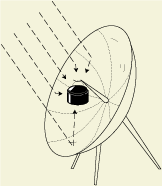 Seyoum Goitom is a 38 year old inventor from Eritrea that has designed and built a number of eco-friendly devices.
Seyoum Goitom is a 38 year old inventor from Eritrea that has designed and built a number of eco-friendly devices.
He is one of the most experienced and talented mechanics in his home town, in spite of not having attended any kind of technical college. Seyoum taught himself nearly everything he knows about repairing gadgets.
Seyoum got funding from the Dutch embassy in Eritrea for his latest idea: a solar powered cooker.
He is convinced that the cooker will interest enough of his fellow country men, and in the long run, it will help to stop cutting down trees for firewood.
Some 95 percent of Eritrea’s forests have already been lost in the past century because of drought, a growing population and during the war for independence from Ethiopia.
The most significant environmental problems in Eritrea are deforestation, desertification, soil erosion, overgrazing, famine, and damage due to the infrastructure from warfare.
Widespread deforestation, which is one of the the main causes for desertification, is also a major threat to Africa’s most vulnerable communities. Seyoum uses an old satellite dish covered in tin-foil that has been converted into a solar cooker.
Seyoum uses an old satellite dish covered in tin-foil that has been converted into a solar cooker.
Solar cookers are devices that heat food using only solar energy.
Since they use no fuel and they cost nothing to run, many humanitarian organizations are promoting their use worldwide to help slow deforestation and desertification caused by the need for firewood used to cook.
Solar cookers can be also used in outdoors cooking, especially in situations where minimal fuel consumption or fire risk are considered highly important.
Most solar cookers work on basic principles: sunlight is converted to heat energy that is retained for cooking.
Sunlight is the "fuel." A solar cooker needs an outdoor spot that is sunny for several hours and protected from strong wind, and where food will be safe.
Obviously, solar cookers don't work at night or on cloudy days.
Dark surfaces get very hot in sunlight, whereas light surfaces don't. Food cooks best in dark, shallow, thin metal pots with dark, tight-fitting lids to hold in heat and moisture.
A transparent heat trap around the dark pot lets in sunlight, but keeps in the heat. This is a clear, heat-resistant plastic bag or large inverted glass bowl (in panel cookers) or an insulated box with a glass or plastic window (in box cookers).
Curved concentrator cookers, such as the one shown in the illustration, typically don't require a heat trap .
External Links:
- Solar Cooking Archive
- Compendium of Solar Cooker Designs
- Hybrid solar oven
- Cornell University ESW Solar Oven Project
- High Quality Solar Grill
- Solar Cookers International
2 comments:
inspiring! i wish for his success.
Please visit the Solar Cooking Archive Wiki for more information on this topic.
Post a Comment